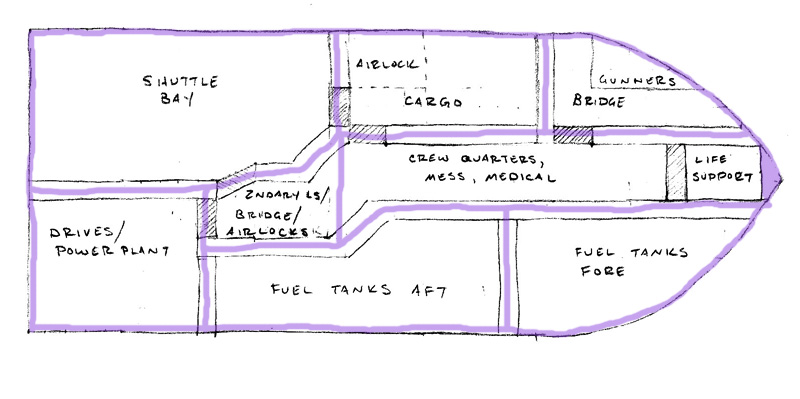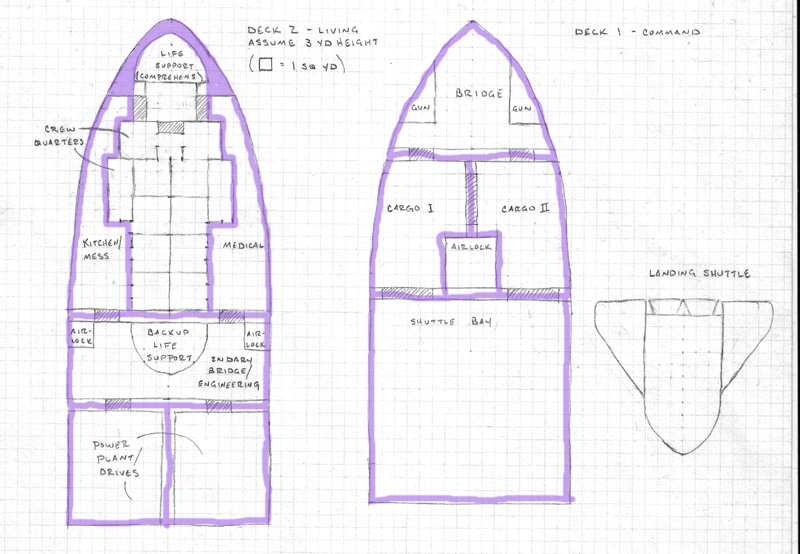Ship Name: TBD
Summary: Main ship consists of a roughly conical nose, 12 yd height x 8 yd radius base = 804 yd3, mainly containing the bridge, gun turrets, and main life support; together with a cylindrical body, 28 yd height x 8 yd radius cross section = 5630 yd3, containing crew quarters for 24, medical, kitchen/mess, cargo bays, airlocks, shuttle bay, power and drives, secondary bridge/engineering, and fuel storage. Total volume 6434 yd3. Armored. Total compartmentalization except for partitions between individual (double-occupancy) crew bunks.
Excursions to the surface are via the landing shuttle, 8 yd long cylinder (3 yd radius) capped with a roughly hemispherical nose (3 yd radius) for a total volume of 282.5 yd3. Seating capacity for the whole crew for emergency situations; under normal conditions only 6-10 at a time will journey to the landing sites. Armored. Winged streamlining. Compartmentalization between fuel tank and cockpit/drives.
Bridge/Cargo Level
Main bridge (approx. 80 yd2 of floor space) in the forward section. Two gunners' stations are mounted from the "ceiling" of the compartment. Clearance under gunners' stations is 2 yds; clearance elsewhere reaches a max of 5 yds. Bridge contains crew seating, calculating and sensing equipment, pilot controls. Space allotted for Miss Hawkwood's mechanical man (weight: 2650 lbs).
Aft of the bridge are the port and starboard cargo bays. Volume of each is approximated by a quarter-cylinder of radius 5yd and length 10yd for a total cargo volume of 393 yd3. Airlock opens onto dorsal side of ship.
Aft of the cargo bays is the shuttle bay, which contains the landing shuttle.
Crew Level
The middle section of the ship is devoted to crew quarters, life support, medical and mess/living areas, and an engineering/secondary bridge area with access to life support, power generators, and drives. Two small (4 person) airlocks open from engineering to the port and starboard sides of the ship. Clearance in most areas is 3 yds.
Crew quarters consist of twelve double-occupancy cubicles, most 3x3x3 yds. Bridge access is at the forward section of the crew quarters, adjacent to main life support unit. Medical section runs along the port side of the crew quarters and accesses port cargo bay, mess area runs along starboard and accesses starboard cargo bay on the deck above. Engineering, the aftmost section of this deck, has direct access to shuttle bay, power plants, and drives. Engineering also contains secondary life support.
Power, Drives and Fuel
Fuel tanks occupy about a third of the volume of the front 3/4 of the ship. Drives/power plant occupy the back quarter. Total volume of fuel + drives + plants is approximately 2350 yd3. Fuel tanks are compartmentalized into two forward and two rear compartments. Valves can be opened to allow fluid flow between compartments.
Total cost: £ TBD
Main Ship:
Hull
Hull base weight: 6434 yd3 x 0.02 tons/yd3 (total compart.) = 129 tons
Hull base cost: 6434 yd3 x £ 140/yd3 (total compart.) = £ 900760
Standard living accommodations add an additional 1 ton per person. Crew of 24 = 24 tons.
Armour, DF 1 weight: 6434 yd3 x .2 ton/yd3 = 1287 tons
Armour, DF 1 cost: 6434 yd3 x £ 35/yd3 = £ 225190
Rationale: Although heavy, armour may prove invaluable in the debris-ridden asteroid belt. Additional armour, at DF2, is probably too much of a liability in terms of weight.
Stress rating: The main ship won't land, so we'll stick with a 1G stress rating.
Total mass with 1G stress rating: 129+24+1287 = 1440 tons
Total cost with 1G stress rating: (900760+225190) x 1.5 = £ 1,125,950
Streamlining: Not necessary, as main ship isn't designed to enter atmosphere.
Power and Drives
Total space for chemical drives, fuel and fuel cells: 2350 yd3.
1 AU = 93 000 000 mi, thus longest distance between two points
in-game is 125 000 000 mi = 1.34 AU
Time (hours) = 68 x sqrt(D/A) where D is distance in AU, A is accel in Gs.
Accel of 0.0089 G will allow travel of 1 AU in 1 month.
Total loaded mass approx 2000 tons (1440 hull mass plus shuttle plus
cargo plus crew plus equipment).
Allot 765 yd3 to O2 = 867 tons, 1535 yd3 to H2 = 107 tons, 3.25 MW
power output for 1 month.
Directing 2 MW to drives gives a thrust of 2/13 = 0.15 tons, for an acceleration of 0.15/2000 = 0.000077 G. 1 MW goes into life support, remaining 0.25 MW into recharging capacitors for the shuttle, weapons system, and others. Fully recharging four shuttle capacitors would require 16 hours.
I think it would be amusing to incorporate an "ionic sail" to "sail the solar wind" -- something (most likely an experimental backup system) that harnesses all that great electromagnetic activity either for motion control or power generation. I think this keeps with the sci-fi/steampunk feel of the game; I did stumble upon some suggestions online of how it might be accomplished, although I'm not sure how consistent they are with the hybrid tech level of the gameworld. On the other hand, if transistors have been invented already, it seems within the realm of possibility.
Mostly I just think a spaceship with a big ol' deployable electromagnetic sail on it would look wicked cool.
Li sez: 30 minutes to deploy and 60 minutes to stow with automated systems, or 6 hours and 12 hours manually. Requires 1 cubic yard for storage and weighs 0.2 ton per 1000 square yards of sail. Costs $25/square yard, with failure rate 10% higher than normal.
Living Quarters
Comprehensive life support for 24, plus backup system: 28 tons, £ 1190,
requires 1MW
24 crew chairs: 12 tons, £ 840
Crew accommodations for 24: £ 3360 (weight already allotted in hull calc)
Armament
Two gunners' stations. Mostly I'm going for "deter space pirates and shady competitors from messing with us". Cost?
Sensory and Calculating Equipment
We're a ship full of scientists and engineers. We're bound to have a ton of this. Miss Hawkwood's mechanical man may have some calculating functionality, perhaps. We will certainly have radar, at least two calculating machines, and some form of communications equipment between main and secondary bridge and other parts of the ship. How good is radio technology? Are there standard communications devices for communicating with bases as we approach? A more comprehensive equipment list TBD.
Airlocks, etc
Three standard airlocks (tentative): 3 tons, £ 1050
Two passage tubes (tentative): 2 ton, £ 210
Landing gear: Not needed, as main ship won't enter an atmosphere
Secondary bridge: Yes. Need to make sure my main vs secondary bridge sizes
are working out OK. I designed the layout before I saw the note about the
main bridge needing to be at least twice the size (is that in yd2 of floor
space or yd3 of volume?) of the secondary.
Cargo space: Volume described above.
Shuttle:
Hull
Hull base weight: 282.5 yd3 x 0.01 tons/yd3 = 2.825 tons
Hull base cost: 282.5 yd3 x £ 70/yd3 = £ 19775
Armour, DF 1 weight: 282.5 yd3 x .2 ton/yd3 = 56.5 tons
Armour, DF 1 cost: 282.5 yd3 x £ 35/yd3 = £ 9887.5
Total mass with 2G stress rating: (56.5+2.8) x 1.5 = 89.0 tons
Total cost with 2G stress rating: (19775+19775) x 1.5 = £ 44494
Total mass with winged streamlining: 89.0 x 1.25 = 111 tons
Total cost with winged streamlining: 59325 x 2 = £ 88988
Power and Drives
With a chemical drive, 13 MW of power provide 1 ton of thrust. However, generating this thrust requires 0.05 ton/MW x 13 MW = 0.65 tons of fuel. Therefore, when takeoff commences, approximately 2/3 of each ton of thrust is required to lift the fuel necessary to generate the thrust.
With a total loaded shuttle weight (minus fuel) of 150 tons, using 14400 MW power from four capacitors requires 720 tons fuel in 1440 yd3 of tank space and gives a thrust of 1107 tons, for an initial acceleration of 1.27 G. This gives a time to escape Earth's gravity of 18 min / (1.27 - 1) = 67 min.
Note that the shuttle's fuel tanks are smaller than 1440 yd3, therefore takeoff from Earth will be an assisted takeoff with breakaway external fuel tanks.
The only other takeoff from a significant gravity environment will be Mars, which has gravity approx 1/3 that of Earth. Fuel tanks on the shuttle have a total volume of 200 yd3, therefore takeoff from Mars can use up to 2000 MW. Total loaded weight (with 200 yd3 = 100 tons fuel) is a maximum of 150 + 100 = 250 tons. However, since gravity is 1/3 that of Earth, effective total mass is 250/3 = 83 ton. Thrust from 2000 MW power is 2000/13 = 154 tons, for a takeoff acceleration from Mars of 154/83 = 1.84 Gm (where Gm is local Mars gravity). Time to escape Mars gravity is therefore 21.4 minutes, and can easily be accomplished without the use of exterior fuel tanks.
All other takeoffs will be in a low-G environment, therefore fuel required to escape gravity will be well within the capacity of the shuttle.
Living Accommodations
Limited life support (50 person-days): 5 tons, £ 875
Six crew chairs: 3 tons, £ 210
Eightteen passenger chairs: 4.5 tons, £ 315
Armament
One small just-in-case weapons system. Runs off capacitor power not required for thrust. (Note that all capacitor power is being used for initial Earth takeoff, so weapons systems will not be powered then. All other takeoffs require less power, so weapons systems will be operational.)
Sensory and Calculating Equipment
A calculator, some form of radar, communications to the main ship and the landing sites, standard fuel/speed/emergency sensors.
Airlocks, Etc
Landing gear. Loaded shuttle weight max 250 tons, thus landing gear has weight 2.5 tons. Retractable, requires storage space of 2.5 yd3, cost $25000 = £ 875.
Calculations
Still need to find out a little more about available power, drives, fuel requirements; and to estimate per-person cargo weights.
Over the weekend I'll try to get my schematics scanned in. Yes, I've put a ridiculous amount of time into making the layout make geometric sense.
(See below. Purple outlines indicate compartmentalization. Hatched rectangles are doors. In the side view, there should be and indication of doors between bridge and cargo, as seen in top view. Some relative sizes will be adjusted when I've got more info on space requirements for power/drives/fuel storage. But this gives the general idea for the layout I've got in mind for the main ship. Shuttle is shown for size purposes; no detailed layout/compartmentalization of it yet.)

